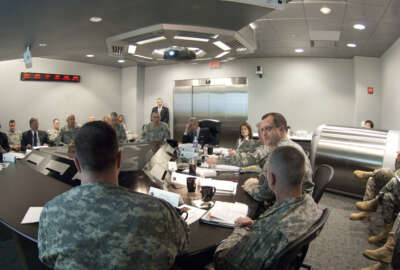
Army CIO wants new governance council to drive discipline in IT spending
Raj Iyer, the Army's new chief information officer, is proposing a new IT governance structure that would be chaired by the Army CIO's office. The current decis...
Chief information officers have a lot of authority under federal law. The Army’s new CIO says it’s time to actually use it.
Raj Iyer, who became the Army’s first CIO two months ago after the service’s decision to split its former CIO/G-6 organization in two, wants to drive more discipline into the service’s IT strategies, make sure the Army sticks to the IT spending levels it’s promised Congress, and take a “ruthless” approach to cutting out legacy systems.
The reorganization of the Army’s IT leadership structure created a dedicated civilian CIO position — responsible mainly for strategy, policy and governance — and put a separate general officer position on the Army Staff, the G-6, mainly in charge of executing those policies.
Iyer said the result is the most “empowered” CIO the Army has ever had. He says one of his first tasks is to eliminate outdated policy strictures.
“If there is a commander in the field that wants to leverage technology to meet the mission outcomes and there’s some policy that’s standing in the way, that’s the first thing we’re going to go after,” he said at a recent event organized by AFCEA’s northern Virginia chapter. “We’ll have to make sure we balance that against cyber risks and acquisition laws and everything else we have to comply with, but I believe today the Army continues to be hampered and constrained by legacy policies.”
Another problem Iyer aims to tackle: inadequate IT governance structures.
“Over the years, because the Army did not have an empowered CIO, the decision making and the responsibilities have gotten distributed across the Army when it comes to decision making and looking across our portfolios, whether it’s the budgeting process, or whether it’s how we provide oversight into programs of record, or how we look at legacy system divestment, or how, what, and when we’re going to move to the cloud,” he said. “So many of those decisions have gotten distributed down to different levels, and that has led us to suboptimal decisions. Commanders make decisions that are important from their perspective, and that’s absolutely what they need to be doing. But it doesn’t lead us to an enterprise approach.”
Iyer’s proposed solution is to stand up a new governance body called the Army Digital Oversight Council (ADOC). The CIO would chair that council, which would serve as something like a board of directors for Army decision making in the digital realm.
It would report directly to the vice chief of staff of the Army and the Army undersecretary. Besides the CIO, its membership would also include major commands and other IT stakeholders throughout the Army.
Iyer said Ryan McCarthy, the outgoing Army Secretary had already assented to the new structure, but said he wants to wait for the new administration’s civilian leadership to sign off on the ADOC’s charter before formalizing it.
“This is all about change management and asking the Army to do something that it has never done before, so I’m taking the time to talk to my peers and to the four-star commanders to get their buy in,” he said. “Meanwhile, I’m having good conversations, informal discussions. It’s been very, very positive. Everybody wants a CIO, and now the challenge is going to be we have to deliver.”
If the Army’s incoming leadership approves the new governance structure, one of its major functions will be to deliver more agency-level budget oversight to programs the Army is already spending money on.
As of now, Iyer said, the decentralized nature of Army IT spending means many different programs wind up spending more money than was budgeted when it comes time to actually obligate dollars on contracts. And collectively, those individual decisions cause the Army to overspend its IT budget by about $2 billion each year.
“We’re looking at about $15 billion that we budget for on an annual basis, and we spend $16 or $17 billion. So what contributes to that? And is that sustainable? Obviously we can’t do that,” he said. “We have changes in scope, changes in schedule, changes in priority. And oftentimes these decisions were made by people who don’t really look at what it means to our growing IT budget over the years. That’s one of the top priorities I’ve been asked to take on: how to get control of our growing cost of IT and ask the tough questions.”
Iyer said he also plans to take a more active role in some of the areas where the Army spends large amounts of money on information technology, but haven’t traditionally captured a large amount of the CIO’s attention.
He said historically the CIO/G-6 organization has spent most of its time thinking about building and sustaining the Army’s networks. Going forward, most of that responsibility will fall under the purview of the new Army G-6, Lt. Gen. John Morrison.
The new division of labor will give the CIO’s office more time to focus on the Army’s other three IT mission areas.
“I’m so happy to have him as my partner in crime when it comes to the network, because that is just one part of my portfolio — but it’s about a $4.5 billion per year part of the portfolio,” Iyer said. “But then I also have to worry about the business systems portfolio … that’s a huge component that includes things like how we’re going to converge our enterprise business systems. It’s also looking at what is happening in our intelligence portfolio, working with the intelligence community and the G-2. And there’s also the warfighter mission area. When you look at these four major portfolios, I’m really happy to outsource the network to Lt. Gen. Morrison, who is absolutely the best guy to get the job done. And while he’s looking at that, I provide oversight over the network as well as the other three portfolios, and I can make those hard tradeoff decisions across those portfolios.
A foundational part of the way the CIO’s office will make those tradeoff decisions is an embrace of Technology Business Management (TBM).
That approach is widely used in private industry, and the Office of Management and Budget has been pressing federal agencies to adopt it for years. But it’s never quite taken hold in DoD.
“We’re going to mandate the use of TBM across the Army to make sure that our IT investments are aligned to mission outcomes,” he said. “It comes with industry standard metrics and key performance indicators for how we measure ourselves, and there’s no reason we have to go invent this on our own. It’s going to help us make some really hard decisions on how we want to divest our portfolio. We’re going to look at how the IT budget aligns to the Army priorities: People First, readiness, and modernization. If it doesn’t align to those three, why are we spending any money on those systems and programs?”
Copyright © 2024 Federal News Network. All rights reserved. This website is not intended for users located within the European Economic Area.
Jared Serbu is deputy editor of Federal News Network and reports on the Defense Department’s contracting, legislative, workforce and IT issues.
Follow @jserbuWFED
Related Stories

CIO Council reawakens push to use Technology Business Management standards




